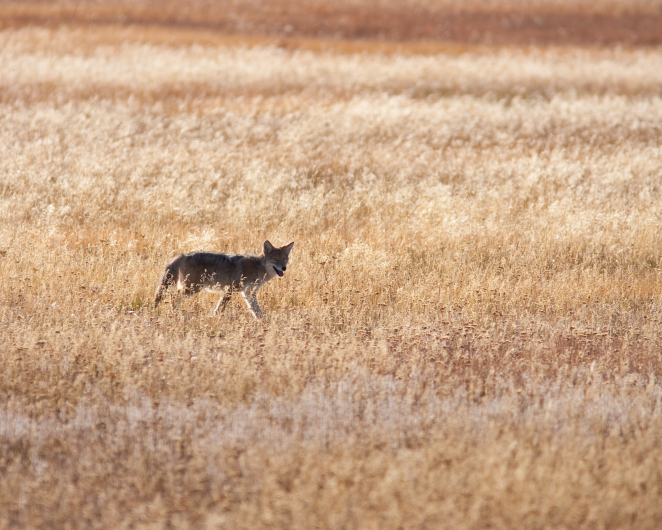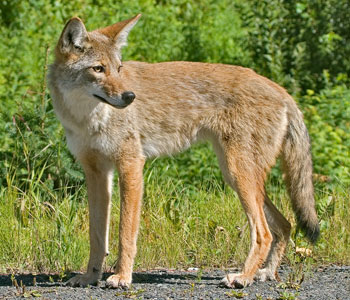Coyote populations have expanded to become the most widespread large predators in North America , extending from the great northern Canadian forests to the deserts of Mexico, and to golf courses and parks of large metropolitan cities from Los Angeles to New York City.
, extending from the great northern Canadian forests to the deserts of Mexico, and to golf courses and parks of large metropolitan cities from Los Angeles to New York City.
The near-extermination of their natural enemy, the wolf, and their amazing ability to adapt to nearly any environment has enabled them to expand and thrive.
them to expand and thrive.
Among their survival gifts is the ability of coyotes to learn human routines by watching and studying them. “Nowhere are those routines more regular than on the trails of parks,” says Derek Quann, resource conservation manager with Parks Canada. “You’ve got lots of people walking in a confined area, coyotes realize they’re not getting off the path. They may think they can get close because people haven’t scared them away or shot at them.” This is likely a reason that coyotes seem more bold when encountering humans, and do not bolt and run at the sight of them.
them. “Nowhere are those routines more regular than on the trails of parks,” says Derek Quann, resource conservation manager with Parks Canada. “You’ve got lots of people walking in a confined area, coyotes realize they’re not getting off the path. They may think they can get close because people haven’t scared them away or shot at them.” This is likely a reason that coyotes seem more bold when encountering humans, and do not bolt and run at the sight of them.
Coyotes have also learned locations of easy sources of food, such as at municipal dumps, campground garbage cans, suburban areas with a large selection of feral cats and small pets, as well as humans feeding them which makes them likely to be spotted more frequently.
But coming close to a coyote does not mean he is dangerous to you. They remain wary of humans which are too large for prey (the average coyote weighs about 35 pounds), do not hunt in packs – as wolves do in order to bring down prey much larger than they are, and have great survival instincts in avoiding anything that could bring them harm (such as humans with guns).
than they are, and have great survival instincts in avoiding anything that could bring them harm (such as humans with guns).
From 1960 through 2007 there were 142 reported coyote attacks on people in the U.S. and Canada (compared with 4.5 million domestic dog bites). Most have been minor bites rather than savage attacks, and the majority of these have occurred within the past twenty years in heavily populated areas of California. In Yellowstone hundreds of coyotes have established territories in areas frequented by over 3 million annual visitors, yet there have been less than half a dozen coyote/human incidents over several decades – and each one involved animals that had been fed by tourists. “I’d be hard pressed to think of any incident, involving a bear, bison, elk, or coyote”, says a park spokesperson, “that either wasn’t precipitated by a human’s close proximity to an animal or one that has become conditioned to eating human food.”
coyote attacks on people in the U.S. and Canada (compared with 4.5 million domestic dog bites). Most have been minor bites rather than savage attacks, and the majority of these have occurred within the past twenty years in heavily populated areas of California. In Yellowstone hundreds of coyotes have established territories in areas frequented by over 3 million annual visitors, yet there have been less than half a dozen coyote/human incidents over several decades – and each one involved animals that had been fed by tourists. “I’d be hard pressed to think of any incident, involving a bear, bison, elk, or coyote”, says a park spokesperson, “that either wasn’t precipitated by a human’s close proximity to an animal or one that has become conditioned to eating human food.”
So what do you do if confronted by a coyote that has gotten a litttle too curious about you. Most, including urban and park coyotes accustomed to humans, will be frightened away by aggressive behavior , such as throwing sticks or rocks and shouting. Most importantly though to avoid conflict, do not leave food around your campsite, keep a close eye on small children, and keep small pets on leash or inside your RV if you leave your campsite.
, such as throwing sticks or rocks and shouting. Most importantly though to avoid conflict, do not leave food around your campsite, keep a close eye on small children, and keep small pets on leash or inside your RV if you leave your campsite.
A different situation has arisen in the Eastern US, where eastern coyotes have bred with wolves and have combined the wolves pack hunting trait with the boldness of the coyote, and may be more dangerous than the western coyote because of their size and physical abilities. Though eastern coyotes are far fewer, there have been at least ten attacks in the past several years. But as one authority pointed out, “If a coyote does attack, don’t act like prey. Yell and throw things. The point is to reinstill avoidance behavior.”
Bottom line: There is no need to fear coyotes as long as you know how to deal with them. Instead, enjoy the wildlife experience.
You can find Bob Difley’s RVing ebooks on Amazon Kindle.



